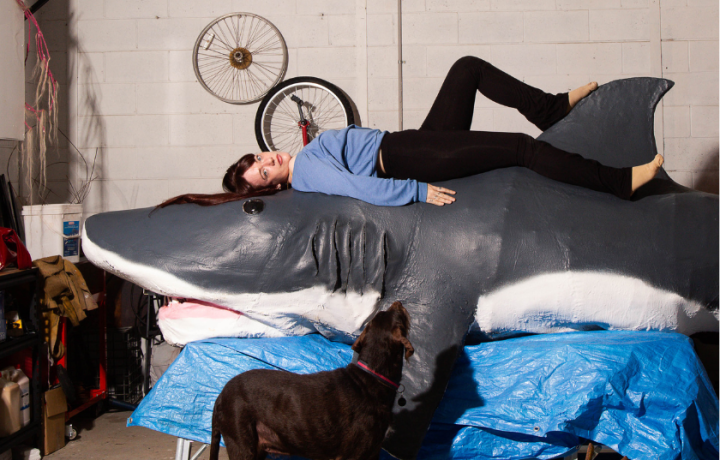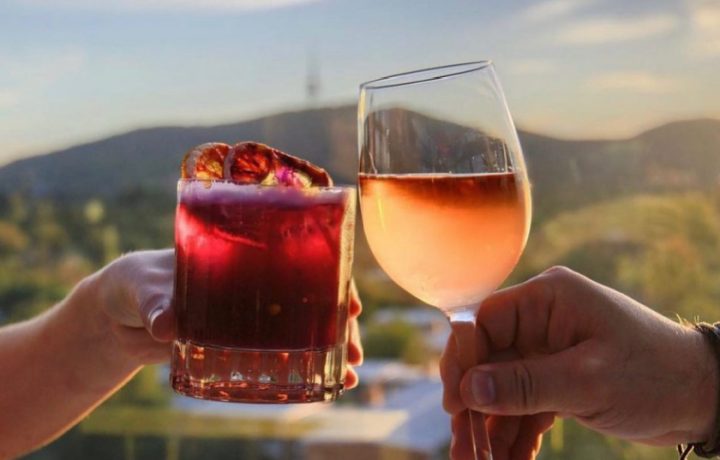How I Got Here: Artist Sophie Dumaresq

Posted on
Admit it, we’ve all been there – stalking social media and LinkedIn profiles, trying desperately to figure out how the hell someone got their dream job.
It seems impossible and yet there they are, living out your career fantasy (minus the itchy business suit). It might seem hard to believe, but once upon a time, they were also fantasising about their future career, and with some hard work, they made it.
Welcome to How I Got Here, HerCanberra’s series that reveals everything you want to know about the secrets of career success. Held on the spectacular Bondi to Tamarama coastal walk, Sculpture by the Sea, Bondi is one of Sydney’s most popular events and is the largest annual sculpture exhibition in the world. Taking place until Monday, 3 November, this year, local Canberra artist Sophie Dumaresq is exhibiting ‘Punk, Romantic’, a kinetic artwork featuring recycled ocean plastics, which pays tribute to the absurdity and beauty of the landscape.
Here’s how she got here.
Existential crisis time: Who are you and what do you do?
My name is Sophie Dumaresq. I am both a physical maker and a performer, which is referred to as an interdisciplinary artist. My artistic practice is rooted in the physicality of making objects with my hands and using my body to perform with them. A lot of my artworks are robotic, mechanical, and or kinetic in nature as they are created to move or engage somehow with my body and or other kinds of forces within a landscape, like the wind, gravity, or sunlight. My practice is centred around what it is to try and communicate within a universe made up of diverse bodies and minds.
Let’s go back to when you were a kid, have you always dreamed of working in this industry?
Yes and no – I’ve always wanted to do something that allows you to stay curious and open to the universe around you, and that also engages and shares that curiosity and openness with others. As a child, a lot of my free time and summers were spent being a pest, tagging along on fieldtrips to both rockpools and farmlands with my dad, who is an ecologist. I found my way into being an artist because I found working and making things with my hands the most natural way for me to express myself. Growing up as someone who is neurodivergent, I was slower to do things like fully develop verbal and other communication skills compared to other children.
Tell us about when you were first starting out, what set a fire in your belly to get here and how did you do it?
Growing up, I really wanted to embody punk rock and to be able to stand up for something, to be able to help make the world a better place and to have that kind of confidence when communicating that I would see from punk rock performers on stage. I very first started in photography by going out and photographing local punk and rock bands.
One of the nice things about getting older is learning to embrace the fact that I am actually really just a massive nerd. One of my favourite Science Fiction books is The Memoirs of a Space Woman by Naomi Mitchison. The book centres around a woman who is the communication officer for her spaceship when they encounter new forms of life while exploring the universe. On one of the first planets, she encounters a civilisation of alien life forms whose brains are so differently shaped from her own that she really struggles to find a way to communicate with them. After almost giving up, she finds herself admiring the aesthetic beauty of the architectural forms created by the civilisation of alien life forms. One of the alien life forms catches her admiring the beauty in their architectural forms and it is through this moment of connection that she is then able to learn how to communicate with the alien life form. Reading this book growing up definitely set a fire in my belly about finding ways to communicate with others, no matter how different their brains are shaped from my own.

Punk, Romantic original performance, 2024.
Recall a time when you wanted to chuck it all in; what did you tell yourself when it got too hard?
My final years at art school were marked by the COVID lockdowns as well as a lot of university budget cuts, so I was unable to be on campus and ended up having to move back in with my parents. During this time, I was also working at a high school and was made an essential worker specifically to help children who had special needs and whose parents were unable to help them navigate their education long-distance over Zoom. For some reason, instead of giving up on my own arts education and arts practice, it made me double down and fully commit to it.
It was during the lockdowns and this time in my life that on days that I wasn’t working at the school, I was in the backyard of my parents’ house building my first ever large scale kinetic and mechanical sculpture called Baby, who is a six meter, 100 kilo plus shark who I still sometimes perform with and who currently lives in my studio.
What was your biggest break?
For me, being selected to be in Sculpture by the Sea, Bondi is my biggest break. It is still all very surreal with moments that are like a dream outside of the everyday nit and grit of the hard work that goes into both the creation of the artwork but also its safe installation and the running of the festival itself. I am so incredibly grateful to have been given this opportunity. One of the first assignments that I ever wrote for art school was to write about two works in past festivals.
What’s the best piece of advice you’ve ever received?
“Just do it, while you can, just do it. Don’t let other people’s opinions make you overthink it, just do it” was a piece of advice I was given by the iconic, world-renowned and also incredibly kind and generous Australian Performance Artist Stelarc.
I was lucky enough to be mentored by him through a Creative Australia fellowship in 2023. He was the first person who fully believed and supported me in doing my first-ever large-scale endurance performance work. The work is called “What’s in a Postcard, Baby I just wanted to make you smile” where I attempt to pull Baby (my first shark) up a hill to try and share the phenomena of a sunset with her. My dog Frankie also joins us in the performance as we attempt to make our way up the hill.
What is it about your industry that you love and what makes you want to pull your hair out?
Juggling deadlines and the needs of a large-scale kinetic artwork and or performances, including my own physical limits can be rough. The thing that I love most about my arts practice is the connections that I get to make with people, the places and landscapes that my work has me encounter. There is what I describe as a warm and fuzzy feeling that I get when all of the moving pieces that go into an artwork or performance, including things like the weather and the way sunlight hits an artwork during a certain time of day, and it just comes together and works.
There is also something about making large-scale hard-to-transport artworks that forces you to have to reach out and learn to work with large systems and diverse networks that you just end up forming bonds and connections, even when it’s hard and you’re pulling your hair out. Some of my closest friends are now people whom I first connected with by doing call-outs for assistants to help me lift a 100-kilo-plus shark onto or off the back of a truck and then taking them out for a drink afterwards to say thank you.
Tell us how you ‘stay in the know’, what media do you consume?
I am pretty Instagram addicted, I hate to say. Art world-wise the Artshub Instagram account is a good one to follow for updates on opportunities for artists at all different stages in their practices. On a local level, I recently discovered a student-created Instagram account called @artcalendar.cbr, which is an amazing resource to keep updated on what art events are happening when and where in Canberra.
Where do you see yourself in five years?
Hopefully still in my studio, making and getting to perform in the company of my dog Frankie, and both old and new sharks and Punk, Romantic artworks.
Why should people follow in your footsteps?
Because their brains are uniquely them-shaped and their ideas, their beauty, and the connections that they will make by being out in the world doing stuff will be uniquely them-shaped and only possible through them.
What advice would you give your past self?
The things that you struggle with and hate most about yourself and your art end up being what other people love and connect most with, so just stop fighting it and embrace the process but it’s also okay to cry, stomp your feet in private, and take that nap when you need to.
Feature image: Sophie Dumaresq in her ANCA studio with Baby, her first mechanical shark and her dog Frankie.

